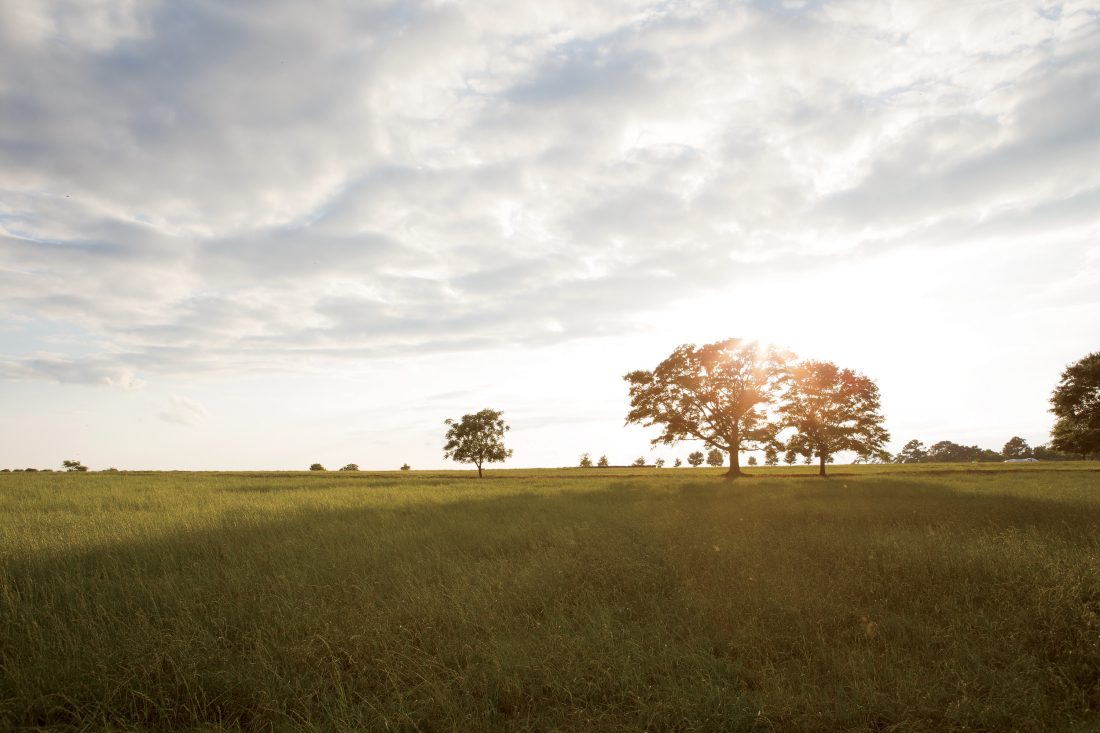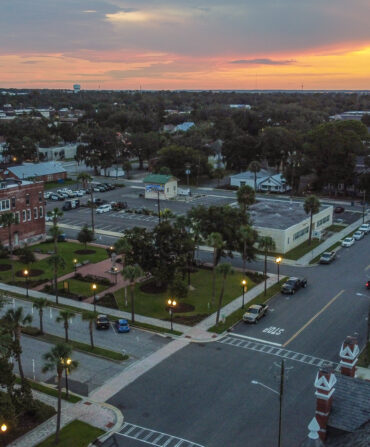Will Harris drives his truck through a copse of shady longleaf pine and parks in a small clearing. “Watch your step,” he warns, pointing to a path that isn’t exactly lined with primroses. “This here’s goat shit, that’s cow shit, and over there’s chicken shit,” he explains, sounding like a demented tour guide. The Serengeti Rotational Grazing Model employed at White Oak Pastures means that at some point any number of creatures will amble by to graze on the grasses and fertilize the soil. Get Harris going, and he’ll even kick up a dung beetle.
At the end of the path lies the Beulah Bell, a sweet one-room cabin named for his grandmother. There is a picnic table out front and a screened porch set behind a gate that keeps curious ruminants out.
“You’ve got to remember this is a working farm,” says Harris, the property’s fourth-generation owner. “It’s not a petting zoo.” White Oak Pastures is indeed a full-fledged farm, the largest certified organic operation in Georgia and a model of sustainability since Harris took over in the nineties and began transitioning the enterprise away from conventional industrial farming methods. Today, the farm’s 2,500 South Georgia acres around the town of Bluffton produce everything from grass-fed beef and pastured poultry to four varieties of eggs, heirloom tomatoes, and butternut squash.
White Oak visitors can now spend the night in one of several lodgings that dot the property. The Beulah Bell counts among four cabins nestled in this pine grove alongside a grazing field where an ever-changing cohort of cows, goats, sheep, ducks, geese, and laying hens stay busy. A pond house up the road can accommodate up to six people in a secluded waterfront setting. Later this fall, Harris will begin renting out a rustic garden-side cottage outfitted with its own paddock, since more than a few would-be guests have asked where they can park their horses.

Photo: Amanda Greene
Jenni Harris (left) and Jodi Harris Benoit with their father, Will, in his signature white Stetson.
Guests begin the day with a fascinating tour of the multimodal farm. You have your choice of activities and Saturday workshops that range from fishing and horseback riding to hide tanning, beekeeping, and mushroom cultivation. At the open-air restaurant—a pitched roof over rows of picnic tables—chef Reid Harrison, a Cordon Bleu graduate, cooks as much as possible from the surrounding acreage. There are simple, fresh standards like grilled chicken sandwiches and bowls of guinea hen and rice soup, and for the more adventurous, pickled beef tongue tacos served in homemade corn tortillas with Bull’s Blood beet greens. A small store sells provisions to bring back to the cabin kitchens.
Harris built the cabins late last year at the urging of his daughter Jodi Harris Benoit, who manages the farm’s burgeoning agritourism endeavor. “We would have folks who drove from Miami and Atlanta just to take an hour tour,” she recalls. More and more visitors began asking about a place to stay, and she’d send them to the nearest motel, twelve miles away. “That was kind of an eye-opener. Finally, I just said, ‘Hey, Dad, we need lodging.’” Nearly a year later weekends book out, mostly with “farmies and foodies,” but also with vacationing families who stop by en route to the Florida Panhandle, and groups of women who arrive with bottles of wine for a girls’ getaway.
After Harris drives me around the property to show me some of his latest projects—a sounder of long-snouted Iberian pigs he plans on breeding for ham, a malodorous “mating chamber” for the black soldier flies raised for chicken feed—he deposits me at the pond house. It stands at the tip of a small promontory, so that when I take a seat on the porch, I’m surrounded by water. Without any cell service or Internet, not one byte of e-mail can reach this blessed place. A rowboat and fishing tackle beckon me to go try for bass, but I’m happy spending the afternoon with a book and the company of a great blue heron.

Photo: Amanda Greene
White Oak’s heritage-breed chickens roam wild.
The next morning I return to the compound to meet Harris Benoit at the farm store for my tour. The cooler holds items such as T-bone steaks and fist-size goose eggs. Jars of bone broth and cakes of beef tallow soap line the shelves. Turkey claw dog treats fill a bin by the cash register.
Harris Benoit pops out of her office and sunnily asks, “Would you like to see the kill floor?” Designed by the behavioral scientist Temple Grandin to cause as little stress as possible on the animals, it lies just beyond a set of swinging doors. Visitors are not required to see it, of course, but there are no secrets on this farm. We enter to find the workers hanging two sides of beef. We walk outside, where Harris Benoit points out a whirring machine that converts the blood into fertilizer. None of the animal goes to waste: The bones will be crushed for soil enrichment, the hides tanned, the horned skulls bleached and sold for home decor.
After pointing out the solar photovoltaic array that helps power the slaughterhouse, Harris Benoit leads me into the dark, quiet “biddy and bunny brooder,” where the cuteness overload provides a welcome rejoinder to the gristle.
As we continue the tour, I begin to see the interrelatedness of all parts of the operation. Egg candlers are set up in a pitch-dark room and shine lights through chicken, goose, guinea, and duck eggs, highlighting any cracks or imperfections. Eggs that don’t pass go into a bucket for the hogs.

Photo: Amanda Greene
A salad at the on-site restaurant.
After walking through the six-acre organic garden, where tiny microgreens grow alongside massive heads of cabbage, we wind up at the poultry slaughterhouse, a bookend to the first stop. The mechanical chicken plucker is something to behold.
Maybe the farming life has truly rubbed off on me because by this point I’m ravenous and ready to join the farmers and butchers in the restaurant for a daily plate lunch of barbecued beef with cabbage, beans, greens, and cornbread. But I can’t resist the thick burger made with White Oak–raised beef and topped with pastured bacon, a fried egg, rosemary aioli, and a frill of fresh greens. Then I fill my cooler with what might be the ultimate farmers’ market haul before the drive back to urban life. Wait until the folks back home in Atlanta see those goose eggs.









